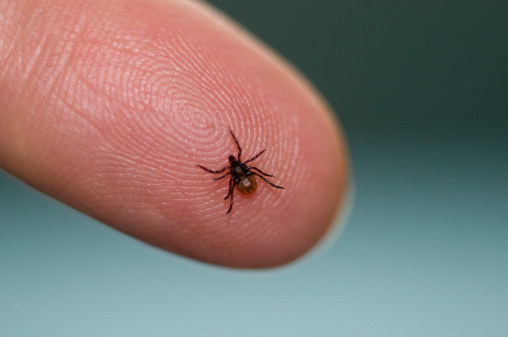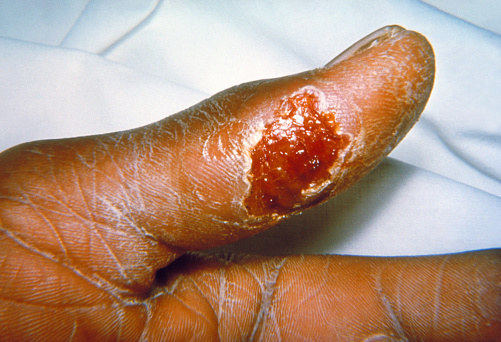Despite their tiny size, ticks are surprisingly powerful vectors of disease. And in the US, the risk of tick-borne infections is increasing. According to a new report from the US Centers for Disease Control and Prevention (CDC), ticks infected people with seven new germs — including bacteria, parasites, and viruses — between 2004 and 2016.
The CDC recently analyzed data trends for all nationally notifiable diseases caused by the bite of an infected mosquito, tick, or flea. The number of cases has tripled since 2004, to 642,602, and those caused by ticks doubled. Of the tick-borne illnesses, 82% were cases of Lyme disease, a bacterial infection that causes a rash and flu-like symptoms that can spread to the joints and nervous system if left untreated.
Some researchers blame the increase in tick-borne illnesses on the longer summer months; others suspect the increase in cases could also be due to improved awareness and surveillance. Regardless, experts said the increase is alarming and requires a multi-pronged effort to focus on public and environmental health.
Here are eight different germs you can get from ticks, including some of the new ones identified by the CDC in the last 14 years or so.
Babesiosis

Cultura Science / Getty Images / Via gettyimages.com
Babesiosis is a rare disease caused by a microscopic parasite, Babesia microti, which infects red blood cells. It is spread to humans through the bite of an infected black-legged (deer) tick, the same tick that spreads Lyme disease. Younger ticks (nymphs) typically spread the parasite, which means they are extremely tiny — about the size of a poppy seed — and difficult to spot with the naked eye.
Most cases occur in the Northeast (New York, New Jersey, Massachusetts, Connecticut) or Midwest (Minnesota, Wisconsin) during the spring and summer months. Between 2011 and 2014, there were an average of 1,135 cases reported each year.
Most people who get babesiosis do not develop any symptoms, but some people with weaker immune systems — the elderly, very young, and immunocompromised individuals — may experience mild flu-like symptoms, according to the New York Department of Health.Asymptomatic patients do not require any treatment, but those with symptoms can be treated with a combination of antibiotics.
Ehrlichiosis

Andrei310 / Getty Images / Via gettyimages.com
Ehrilichiosis is a term for a group of bacterial diseases transmitted to humans from ticks — primarily the lone star tick. Most cases occur in June and July in the Midwest and South. The symptoms are similar to a flu — fever, muscle aches, nausea, chills, headache, fatigue — and they usually appear within one or two weeks after being bitten by an infected tick. People over the age of 50 are at higher risk for contracting the illness.
The symptoms might be easily confused with other illnesses at first, but ehrlichiosis can be confirmed with lab tests. It’s typically treated with the antibiotic doxycycline. If treated early, it will go away in a few days, but chronic untreated ehrlichiosis can cause severe symptoms and lead to hospitalization or (rarely) death. The case fatality rate is between 0.9% and 3.7%.
Anaplasmosis

Lauree Feldman / Getty Images / Via gettyimages.com
Anaplasmosis is similar to ehrlichiosis, but it is caused by a different type of bacteria and spread to humans by the black-legged (deer) tick and the western black-legged tick. The majority of cases occur during the summer months in the upper midwestern and northeastern states. The average number of cases each year has steadily increased since it was discovered in 1999 — from 348 cases in 2000 to 1,761 cases in 2010. The case fatality rate ranges from 0.2%–3%.
The symptoms are also similar to a flu-like illness and appear within one to two weeks after being bitten. Some people may have very few symptoms, and others may develop severe symptoms such as hemorrhaging, kidney failure, or breathing problems. Anaplasmosis is treated with doxycycline in children and adults.
Powassan virus

Kateryna Kon / Getty Images / Via gettyimages.com
The Powassan (POW) virus is a rare virus spread to humans from the deer tick. There are only an average of 9 cases each year — but in 2016, there were 21 cases, double that in previous years. POW virus primarily occurs in the Northeast or Great Lakes region, particularly in Minnesota and Wisconsin. Many people who contract POW virus do not have any symptoms, but those who do may experience a fever, headache, vomiting, and also mental confusion, memory loss, or seizures.
It can take up to a month for symptoms to appear after being bitten by an infected tick. If left untreated, the POW virus can spread to the central nervous system and lead to encephalitis or meningitis. Unfortunately, there is no medication or vaccine to treat or prevent POW virus. About half of those who survive the POW virus will have permanent neurological problems, and 10% of the encephalitis cases caused by POW are fatal, according to the CDC.
Spotted fever rickettsiosis

Photo Researchers / Getty Images / Via gettyimages.com
Spotted fever rickettsiosis is a term for a group of diseases caused by spotted fever group rickettsia, a type of bacteria. These are spread to humans by either mites or ticks — specifically, the Gulf Coast tick and Pacific Coast tick. Since 2010, there have been about 3,000 cases each year with a fatality rate less than 1%. These mostly occur during the summer months in the South and southeastern states.
The first sign of a spotted fever is an eschar, or a dark brown scab on the tick bite, which can take up to a week to appear. Once the eschar forms, patients may experience flu-like symptoms. All spotted fevers are treated with doxycycline.
These infections can range from mild to life-threatening if left untreated. The most serious of this group of tick-borne diseases is the Rocky Mountain spotted fever (RMSF), which causes fever, headache, and rash. In severe cases, RMSF can result in permanent damage to blood vessels in the limbs, hearing loss, paralysis, or mental disabilities.
Heartland virus

Lauree Feldman / Getty Images / Via gettyimages.com
The Heartland virus is thought to be transmitted by the lone star tick, and it’s usually found in parts of the Midwest and Southern US. States where the tick is most common, including Arkansas, Missouri, Indiana, Tennessee, Kentucky, and North Carolina. It was first discovered in 2009 and there have been several cases each year — including two people who have died.
The virus causes flu-like symptoms, such as fever, fatigue, muscle aches, and headaches, and also diarrhea. Patients may also have a low white blood cell count. There is no medicine or vaccine to treat or prevent the Heartland virus.
Bourbon virus

Joao Paulo Burini / Getty Images / Via gettyimages.com
The Bourbon virus is part of a group called thogotoviruses, and it’s relatively new on the radar. There have only been a few cases so far, mostly in the South and Midwest, and some of these patients died. The virus is thought to spread through the bite of an infected tick, but the exact way it infects people is still unknown, according to the CDC.
People who become infected with the Bourbon virus may develop flu-like symptoms as well as nausea and vomiting. They may also have low white blood cell and platelet counts.
The best way to avoid tick-borne illnesses is to use insect repellents, wear long sleeves and pants, and perform tick checks after spending time outdoors in wooded or bushy areas.
If you do find one attached to your body, here’s how to safely remove the tick.
The sooner you remove ticks the better, because the longer a tick is attached, the more likely it is to transfer any germs it might be carrying.
Caroline Kee is a health reporter for BuzzFeed News and is based in New York.
Contact Caroline Kee at caroline.kee@buzzfeed.com.
https://www.buzzfeed.com/carolinekee/rare-tick-borne-diseases-2018?utm_term=.apmJXN7dV#.efG3kXzY0


“…..Some researchers blame the increase in tick-borne illnesses on the longer summer months; others suspect the increase in cases could also be due to improved awareness and surveillance…..”
And they’re all shoveling fertilizer.
I blame the increase in tick-borne illnesses on a biological warfare attack. I lived here (northern Michigan) for three years without ever seeing a tick, and now I pull between 15 and 20 off of me every year. Guys who grew up here say the same thing. They’re an entirely new phenomenon, as if someone dropped a barrel full of them here and drove away.
I’m guessing it’s an Agenda 21 attack, to help move people out of rural areas, and nice places that should belong only to Jews, of course.
Plum Island in New York was where they did a lot of this kind of Biological Warfare research. Nazi scientists brought over from Germany with Operation Paperclip.
That facility was moved to Manhattan Kansas a couple years ago.
Google: Plum Island tick borne diseases
was at the range last weekend zeroing a rifle for my son
never set foot in the woods , just on the grass .. 2 ticks by the time we were done , and only on site for an hour or so
big sons of bitches too
I know what a tick can do to you . Was treated for Lyme over 10 years ago an I still have days when it flares up
There’s an infestation.
Especially. ..the…
PolyTicks.
They are huge blood sucking suit and tie wearing parasites.
The thing about these poly tick tions.
Is that they are an invisible friendly hand up your azz…. feeding off your azz crack sweat labor.
And you can’t even feel it.
Very stealthy.
As a solution. .
I suggest spraying D.C. to get rid of this scourge.
Maybe an Orkin chemtrail spray to kill all the roaches, ticks and leeches.
This comment was brought to you by…
Orkin pesticides. ..
[SLOGAN]
ORKIN…WE’LL Kill those Cockaroach Ratt Bassturds…”
Call The Orkin Man..!
Now back to our regular programming…
And a word from our sponsors.